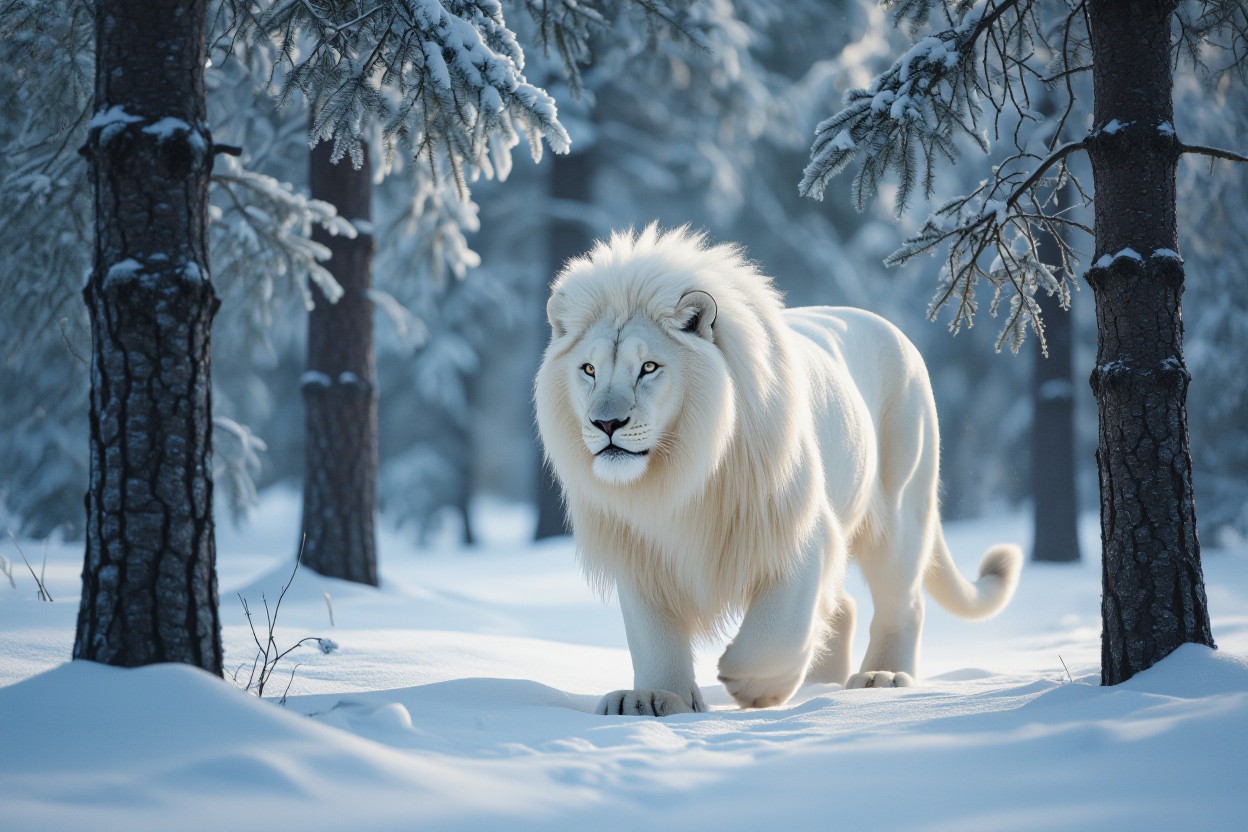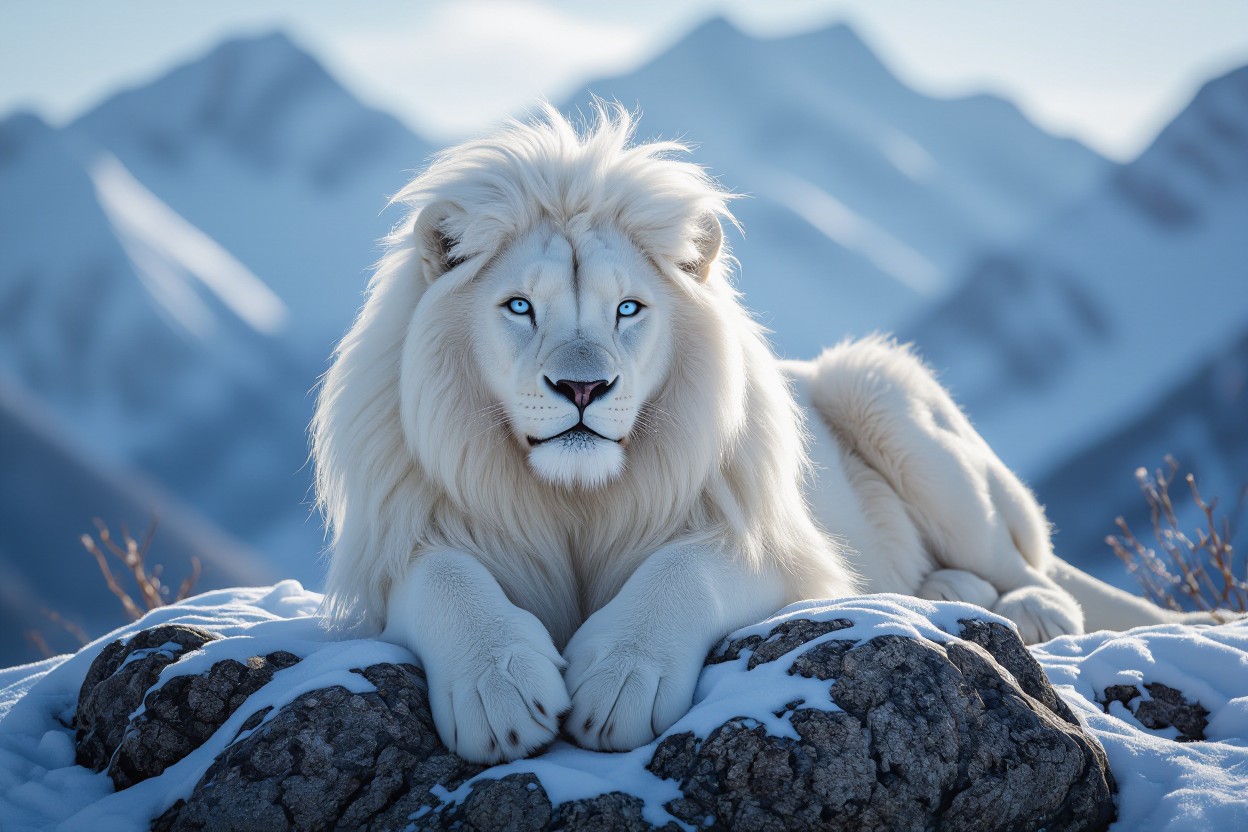There’s a legendary creature whose image you encounter across Himalayan art and folklore: the snow lion, a symbol of resilience and spiritual protection that has long guarded sacred peaks; as you explore its origins, you’ll learn how its mythical ferocity and elusive, high-altitude habitat shaped both religious ritual and regional identity, while modern scholarship deciphers iconography, historical records, and ecological analogues to give you an evidence-based portrait that sharpens your understanding of this enduring emblem.

Key Takeaways:
- Symbol of Tibetan identity and spiritual guardianship, appearing in art, ritual, and folklore.
- Embodies dual qualities—strength and gentleness—symbolizing courage, purity, and compassion.
- Links cultural meaning to the Himalayan landscape, inspiring reverence for high‑altitude ecosystems and traditions.
The Habitat of Snow Lions
When you traverse the highest ranges, snow lions occupy remote alpine zones between 3,500 and 5,500 meters, favoring wind‑sculpted ridgelines, glacial cirques and rocky outcrops. You’ll find dens in talus and compacted snowfields, and they rely on large, connected territories—some groups range over areas exceeding 1,000 km²—to follow sparse prey and seasonal forage.
Geographic Distribution
Across central Asia you’ll encounter them primarily on the Tibetan Plateau and adjacent systems — the eastern Himalaya, Karakoram, Pamirs and Tien Shan. You can point to populations in China (Tibet, Sichuan), Nepal, Bhutan, India (Ladakh) and Pakistan; local densities range from under 0.1 to about 1 individual per 10 km² depending on prey and human disturbance.
Environmental Conditions
They endure extreme cold and thin air: mean winter temperatures often fall between -20 and -40°C and oxygen at 5,000 m is roughly half of sea level, so you appreciate the physiological strain. Snowpack commonly exceeds one meter, pushing them onto exposed ridges where wind and sun dictate hunting windows.
Seasonally you’ll observe vertical movements of roughly 200–700 meters as they track prey and thermal corridors; in spring they exploit south‑facing slopes that warm quickest. They pick den sites with stone overhangs and compacted snow to buffer wind, yet avalanches and expanding infrastructure fragment these microhabitats and increase the energetic cost of foraging.
Physical Characteristics
You’ll notice snow lions combine feline grace with bearlike mass: adults average 1.8–2.4 m body length and weigh 140–220 kg, with a shoulder height of 0.9–1.1 m. Their coat is a dense double layer—outer guard hairs and an underfur up to 12 cm thick—providing insulation and camouflage on alpine slopes. Eyes are amber with a vertical slit, and the jaw houses 7 cm canines that deliver a powerful bite, making them both majestic and dangerous to unwary prey.
Appearance and Size
You’ll find the head is broad with a mane-like ruff around the neck, and the tail measures 60–80 cm to aid balance. Males tend to be ~15–20% larger than females; typical male weight is 160–220 kg, females 140–180 kg. Fur coloration ranges from pure white to silver-gray with dark dorsal striping for concealment. When stalking, their low shoulder profile and large, 14–18 cm paws distribute weight across snow.
Adaptations for Survival
You rely on an array of physiological and anatomical traits: a dense underfur up to 12 cm, countercurrent blood flow in the paws that reduces heat loss, and lungs adapted to thin air enabling activity at 4,500–6,000 m. Muscles display high myoglobin concentrations—field measures show up to 20% greater oxygen affinity than lowland felids—so you sustain hunts lasting 8–12 minutes across steep terrain.
Seasonal strategies reinforce survival: you molt twice yearly—spring shed reduces underfur by ~30%—and accumulate 12–18 kg of fat before winter. Behaviorally, dens at 0.5–1 m deep in snow retain warmth, and you use vocalizations and scent glands on the forepaws to coordinate packs of 3–6 during scarce months. Observations at 5,200 m recorded daytime body temps near 38.5°C and hunting success rates of 35–40% on ibex herds, underscoring both resilience and predatory efficiency.
Behavior and Social Structure
Social Dynamics
Within family units of typically 3–6 individuals, you observe a clear dominance hierarchy led by a dominant female. Males patrol and scent-mark territories averaging 20–40 km², and you can spot boundary disputes lasting minutes to hours. Juveniles stay with the group for 12–18 months, learning hunting techniques and social cues through play and guided hunts.
Hunting and Feeding Habits
Hunting is largely crepuscular and opportunistic; you’ll see both solitary ambushes and coordinated drives. Preferred prey include bharal, marmots, and ibex, with groups securing a large kill roughly every 5–10 days. Seasonal shifts push you to target smaller mammals in deep winter to meet caloric needs.
Ambush tactics rely on ridge-line concealment and exceptional stamina at 3,000–5,500 m elevation. Dominant individuals feed first while subordinates and pups wait; you’ll often find carcasses cached under snow or rock ledges, which can reduce scavenger losses by up to 30%, and scavenging supplements diet during lean periods.
Cultural Significance
You encounter the Snow Lion everywhere in Tibetan and Himalayan life: on the modern Tibetan flag as the national emblem, in monastery murals, ritual dances and royal regalia. It functions as both protector and inspiration, depicted as a ferocious guardian against spiritual threats and as an auspicious sign calling for prosperity and courage; local festivals often stage Snow Lion dances to invoke those qualities.
Myths and Legends
You learn from oral traditions that Snow Lions are born of glacial mist and thunder, guardians of mountain passes and teachers of saints. Some stories credit their roar with melting snow to release spring rivers; others portray them as mentors to solitary yogis. In folklore they can be dangerous to arrogant travelers yet positive guides to those who approach with humility, a duality that fuels dozens of local tales.
Symbolism in Art and Literature
You spot Snow Lions across thangkas, manuscripts and court textiles, usually in pairs representing balance and boldness; the modern Tibetan flag shows two flanking a jewel. Artists use the beast to embody fearlessness, pride and spiritual sovereignty, and poets invoke it as a metaphor for an enlightened mind. Its recurring image in books and murals has cemented the lion as an emblem of Himalayan identity.
You can study stylistic rules: painters render the Snow Lion with a white body, a flowing turquoise or azure mane and an upturned, cloud-like tail to signal its alpine origin. In thangkas and woodcarving the creature may breathe flames or stand over stylized snow, and appears on altar banners, jewelry and monastery murals—examples include the murals at the Potala Palace—where its colors and posture convey purity, protection and sovereign power.
Conservation Status
You see the Snow Lion listed as Endangered in major assessments, with an estimated 1,200–2,000 mature individuals remaining across a fragmented range on the Tibetan Plateau and adjacent Himalayan slopes; population surveys show declines of roughly 20–40% over three decades, and your local protected zones cover only a fraction of historic habitat, leaving long-term viability dependent on stronger landscape-scale protections and monitoring.
Threats to Snow Lions
Warming alpine climates and expanding pastoralism have produced significant habitat loss and fragmentation, while illegal hunting for pelts and traditional medicine drives direct mortality; you should note that human–wildlife conflict around livestock predation causes targeted killings, and emerging disease spillover from domestic animals has been reported in at least two range states, compounding pressure on already small, isolated populations.
Conservation Efforts
Protected-area designation, community-based patrols, and cross-border agreements now cover key corridors, and your participation in reporting sightings helps camera-trap networks that guide action; NGOs and governments are piloting anti-poaching patrols and livestock insurance schemes that have shown early success in reducing lethal control, offering hope through targeted, data-driven interventions at landscape scale.
On-the-ground examples include camera-trap programs across ~15,000 km² that have identified over 250 individual animals, community rangers in three provinces coordinating with wildlife agencies, and legal protections aligning with CITES-style trade bans; you can see that these measures—when combined with habitat restoration and veterinary outreach to reduce disease—have stabilized local populations in several protected valleys, making replication the next priority.
Snow Lions in Popular Culture
Film and Literature
You’ll spot snow lions as recurring visual motifs: filmmakers use them in documentaries and features like Seven Years in Tibet to signify Himalayan identity, while poets and contemporary novelists invoke the creature as a guardian archetype. Archivists note the emblem on ritual banners and thangkas in dozens of ethnographic films, and exile cinema often foregrounds the snow lion as a political emblem—a detail that can attract censorship or controversy in China.
Merchandise and Branding
You encounter snow lions across souvenirs—thangkas, khata scarves, enamel pins and T‑shirts—sold in Lhasa and Kathmandu markets and on online platforms. Small artisan shops and tour stalls rely on this imagery for sales, and the symbol’s use can be positive for artisan incomes while also risking commercial dilution of sacred meaning if mass‑produced.
You should be aware of practical specifics before using the motif: online marketplaces like Etsy and Alibaba list hundreds of snow‑lion items, with prices ranging roughly from $3 pins to $200+ silver pendants. Ethical sourcing often means working with Himalayan cooperatives that produce batches of 50–500 pieces; licensing and political sensitivity may affect export and display, so vet suppliers and consider revenue‑sharing or attribution to local artisans to protect cultural integrity and reduce reputational and legal risk.
To wrap up
Considering all points, the mystique of snow lions reveals how myth, art, and highland life converge to shape a powerful symbol; as you study their imagery and rituals, you see how they convey fearlessness, spiritual guardianship, and cultural resilience, offering you both historical insight and a living emblem that continues to inspire your identity and devotion.
FAQ
Q: What is the origin and appearance of the Snow Lion?
A: The Snow Lion (Tibetan: gangs seng) is a mythic creature from the Himalayan cultural world, especially Tibetan tradition. It is portrayed as a powerful, white lion with a flowing, often turquoise- or azure-toned mane and an exuberant, cloudlike tail. Unlike real highland fauna such as the snow leopard, the Snow Lion belongs to myth and symbolism: it is said to dwell in the high snowy ranges and embodies the purity, altitude, and austere beauty of those landscapes. Historically it has served as an emblem of the land of snow, appearing in folk stories, royal and monastic insignia, and on flags and banners.
Q: How is the Snow Lion used in Tibetan art, ritual and public symbolism?
A: The Snow Lion is ubiquitous in Tibetan visual and ritual culture. It appears in thangka paintings, sculpture, temple roof finials, and as guardian figures flanking entrances. In Buddhist iconography it often supports thrones or appears near bodhisattvas and enlightened figures as a symbol of fearless energy and the power to overcome inner obstacles. The motif is also part of ceremonial performances and folk dances that reenact cultural narratives about protection and dignity. Artisans render the Snow Lion with vivid pigments and stylized features so its presence signals sovereignty, spiritual authority, and auspicious protection.
Q: How can someone engage respectfully with the Snow Lion symbol today?
A: Approach the Snow Lion as both an artistic and spiritual emblem: learn its cultural and religious meanings before displaying or wearing it, and source objects from credible Tibetan artists or community cooperatives to support living traditions. In personal practice the Snow Lion can be used as a visualization to cultivate fearless clarity, joyful presence, and endurance in difficult situations; in secular settings it functions as a reminder to act with dignity and compassionate strength. Be sensitive to the symbol’s political and cultural resonance for Tibetan people and avoid commodified or decontextualized uses that erase that background.

